Peer Reviewed
Feature Article Obstetrics and gynaecology
A practical guide to contraception. Part 1: Contraceptive pills and vaginal rings
Abstract
The shorter-acting contraceptives – the combined hormonal methods (combined oral contraceptives and the vaginal ring) and the progestogen-only pill – are discussed in this first article in a three-part series on contraception. Other contraceptive methods will be discussed in subsequent articles.
Correction A correction for this article was published in the August 2013 issue of Medicine Today. The full text PDF of this article (see link above) has been corrected.
Key Points
- Combined hormonal contraceptives (CHCs), which contain an oestrogen and a progestogen, are available as combined contraceptive pills and the vaginal ring.
- The advantages of CHCs include beneficial effects on acne, decrease in menstrual pain and bleeding and the ability to manipulate menstrual cycles.
- CHC use is associated with some serious risks but the absolute risk is low for most women of reproductive age.
- No serious risks have been associated with use of the progestogen-only pill, although evidence is limited.
- The option of long-acting reversible contraceptives (intrauterine devices and subdermal implants) should be discussed with women renewing CHC scripts.
- Contraceptive methods requiring consistent action (condoms and pills) are less effective than long-acting methods requiring minimal ongoing action on the part of the user (implants and intrauterine devices).
Purchase the PDF version of this article
Already a subscriber? Login here.

